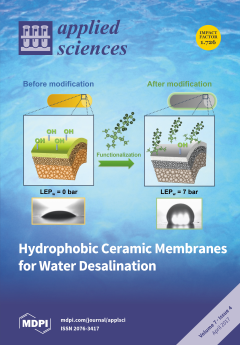Appl. Sci., Volume 7, Issue 4 (April 2017) – 121 articles
In the presented work, TiO2 and Al2O3 ceramic membranes were efficiently functionalized with fluorine-free grafting molecules. As a result, highly hydrophobic surfaces (CA = 111°–132°) possessing low surface free energy (31–52 mN•m-1) and low roughness (23–51 nm) were achieved. Membranes were subsequently tested in air gap membrane distillation showing high permeate flux and salt retention close to 100%. View the paper
- Issues are regarded as officially published after their release is announced to the table of contents alert mailing list.
- You may sign up for e-mail alerts to receive table of contents of newly released issues.
- PDF is the official format for papers published in both, html and pdf forms. To view the papers in pdf format, click on the "PDF Full-text" link, and use the free Adobe Reader to open them.





